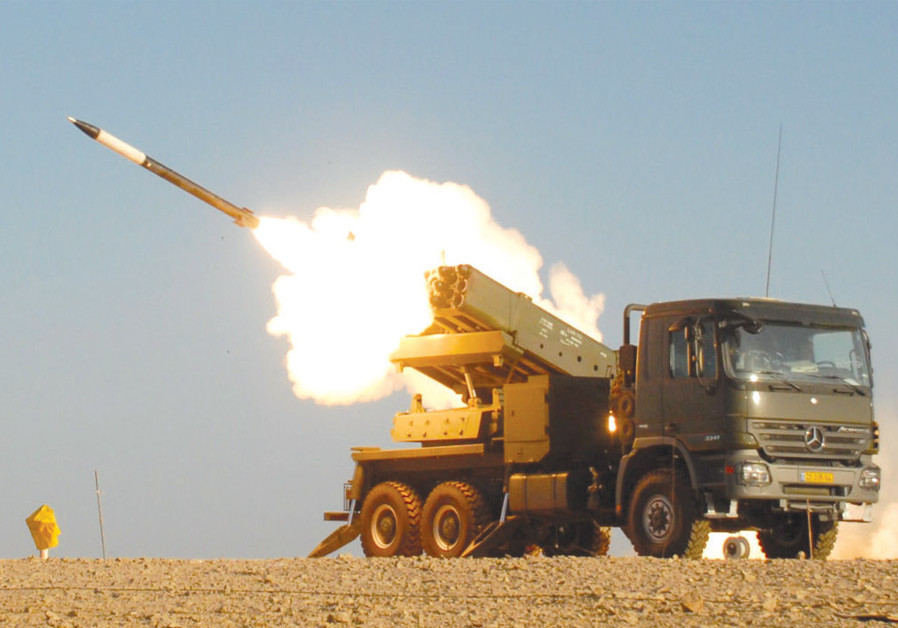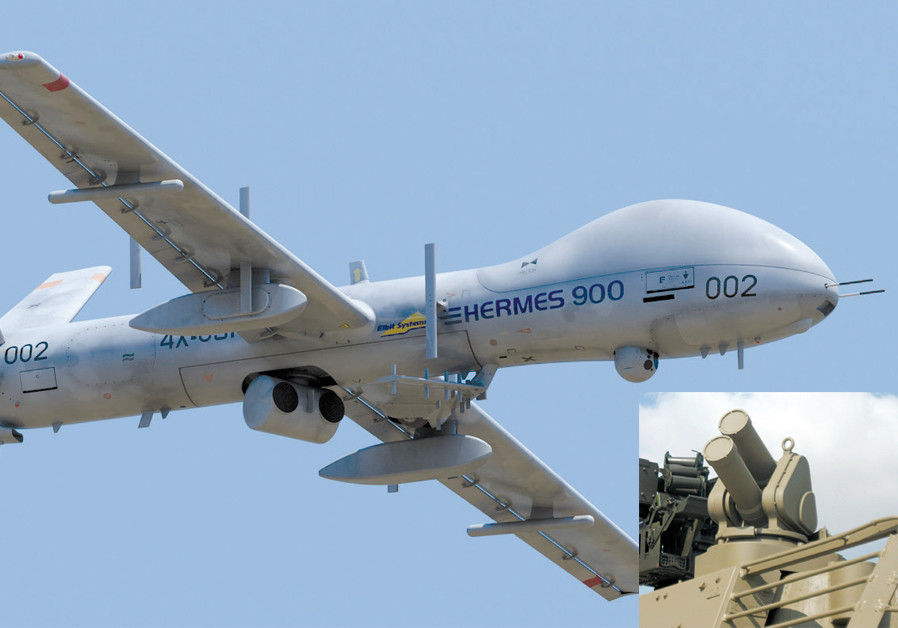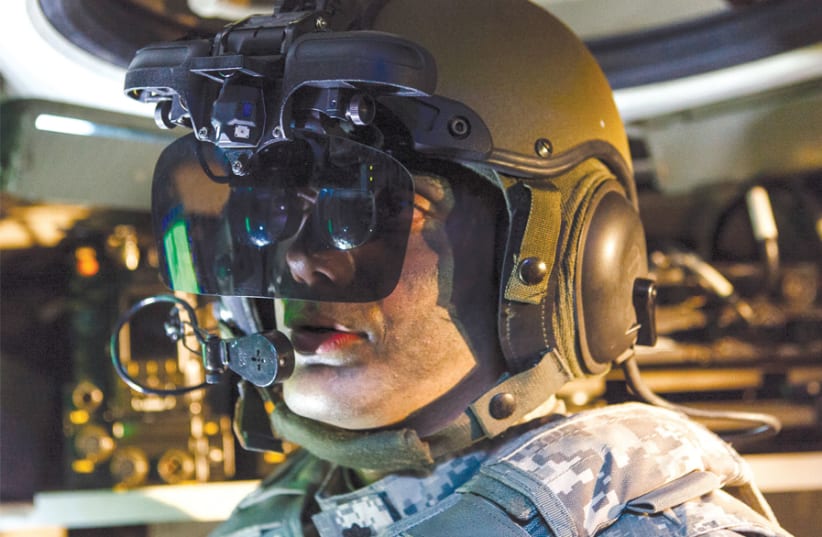Elbit Systems is Israel’s largest defense company and frequently ranks among the most important in the world. In 2018, it was the 27th most important company in its defense field by revenue globally. It is a key part of Israel’s hi-tech and groundbreaking defense technology sector that has made Israel the eighth most important country in defense supplies. In terms of what Israel excels at, weapons platforms such as air defense, improving communications technology and unmanned aircraft systems, including electro-optical imaging, Elbit is integral to the whole ethos of what makes Israel unique. Elbit describes itself as an “international high technology company engaged in a wide range of defense, homeland security and commercial programs around the world.” It’s in the news frequently, most recently for a $30 million high-precision guided mortar sale in Asia, and a new partnership with DA-Group to produce and market Elbit Systems’ Immune Satellite Navigation System (iSNS). This confronts the threat posed by GPS jamming, which has affected Finland and Scandinavian countries. Technology is a key part of war fighting today. The long-arc of the history of warfare has gone through several technological revolutions, from developments like radar in the 1930s to the Revolution in Military Affairs that theorized dominance based on technology. Today’s challenge is even more sophisticated, harnessing every technology to make weapons more precise and armies more aware. To understand how Elbit is changing both the Israeli defense market and the world, the Magazine spoke to Joseph Gaspar, Elbit Systems executive vice president and chief financial officer.
THE DISCUSSION came in the wake of Elbit announcing $3.68b. in revenues for 2018. It also comes in the wake of a long and important acquisition Elbit made of IMI Systems. The world is changing in terms of its needs for military equipment. Many countries that suffer from antiquated weaponry want the technology that Israel has that helps them upgrade things like bombs to turn those “dumb” munitions into smart bombs that are more precise. High-level defense equipment is so expensive, like the US F-35, that countries want to be able to improve what they already have. There are also tensions between Russia and NATO that drive defense spending, and the US pressure for NATO countries to increase their support for the alliance. The decline of ISIS hasn’t meant the end of the war on terror. Instead, the ISIS threat has spread throughout the Sahel in Africa and to south Asia, with the attack in Sri Lanka and other networks. Iran is also on the march and raising tensions in the Middle East.
In every case it is technology of the kind Israel excels at, that is often needed to help check these adversaries. Companies like Elbit want to balance their increasing importance in the US defense market, the largest defense spender in the world, with the rest of the world. For instance, the Stockholm International Peace Research Institute revealed in late April that global defense spending increased to $1.8 trillion in 2018, 2.6% more than in 2017. The US and China are among the largest spenders, but India, Saudi Arabia, France, Russia, the UK and Germany are in the top 10 as well. Israel doesn’t sell to all of these countries, but it sells to many important countries and developing countries.
After announcing $3.68 billion in revenues in 2018, can you describe a bit about Elbit’s acquisition of IMI in terms of how it will impact the company’s approach going forward?“I would say that it was a long process [acquiring IMI]. We were in negotiations with the [Israeli] government for over two years and finally it happened in November last year [2018]. We have a basic strategy of growing the business organically and looking for acquisitions – which we did quite a lot over the years in Israel and abroad. IMI is one more acquisition in Israel that we did to comply with what we think is very strategic for the company, which is growth of our portfolio of technology, products and solutions to offer to customers in Israel and internationally.“Our strategy in acquisition is to enlarge the portfolio and acquire strategic positions in countries and get better access to customers. IMI was categorized in the first part of that. IMI was a government-owned operation with $500m. revenues, give or take, and it was a losing operation. The government was subsidizing them and helping them in many ways, but they were not profitable. We started at the low level and had to bring them all the way up to the level of profitability of Elbit. We have done that in the past.
“One example was ELISRA, an electronics warfare company from Bnei Brak. They had $350m. in revenues and were losing money when we acquired them in 2007. Today, we have built a lot of synergy, and ELISRA is at the profitability rate of the whole organization. It took us several years, but we are there.“We have three major product lines at IMI: precision munitions; short-to-medium and long-range rockets; and defense systems for armored vehicles. All of them are product areas that Elbit did not have offerings in prior to IMI. The acquisition puts us in a new and stronger position in the various markets where we are selling our solutions.“We see quite a lot of synergy potential with the IMI capabilities that we will be able to offer our customers: integrated solutions for ground-based armored vehicles, and integrated artillery solutions that include guns, mortars, rockets and command and control centers. In the past, we were not really able to offer to our customers a wholly integrated one-project solution, but with these capabilities from IMI we are able to offer that one-stop shop for upgrade programs for armored vehicles, including the guns and the protection systems for tanks and armored vehicles; artillery solutions; and small 120 mm weaponry, including mortars; guns and rockets; medium, long range and integrated artillery centers – all of this combined to provide integrated artillery defense solutions.
“In addition, this enables us to provide to our customers with integrated intel and recon systems that we had before, these are usually airborne on vehicles and other airborne platforms, but once we have the capability from IMI we have precision guided munitions to close the loop quickly once the target is detected and identified and can be hit with guided precision munition.
“As we all know the precision munition is important in these days in the modern world. We cannot be part of any munition that has collateral damage or civilian damage accuracy and the whole world is going toward this solution in time and location, this is extremely important and IMI’s solutions are very effective. “We see significant potential from our market presence. Elbit derives 20% of our revenues from the Israeli market and 80% from international markets. IMI is the other way around: 17% from international markets and over 80% from the Israeli market. So we identify a potential to expand that business to the international market, leveraging our worldwide presence and good relationship with customers internationally. We expect the IMI portfolio do derive 60% of its revenues internationally within several years, without reducing its position in Israel.

“With the acquisition of IMI, we believe we are in a different category of defense companies. We are now in the $4-5b. revenues range with a 10b. backlog of orders, which is higher than before. With IMI, we will have a third of our business in Israel for the coming years and about a quarter in Europe, US and Asia-Pacific each. So we have a diversified portfolio and nicely balanced customer base, which minimizes business risk, as defense budgets may decline or grow in some areas in world, but worldwide there is growth. Also, our broad portfolio of products and solutions gives us a solid position. If I compare us to our peers in the US, who are on average 80% US-based and 20% international, we see a lower risk situation for Elbit .
“WE RESTRUCTURED the company after the acquisition to five business units in addition to our US operations.
“We split the land and C4I division into two. The Land Division, which includes IMI, will be focused on land solutions that include armored vehicles, artillery and ammunition. The C4 and Cyber division is focused on command, control, communications, computers, radio and cyber business. “In addition, we have the iSTAR Division, including the UAV and electro-optic business and the airborne and the EW business (ELISRA). In each business division, we are well focused and consider ourselves as one of the three leading companies in the area from the point of view of products, technology and customer base.
“From the operations point of view, IMI is very advanced technologically. They had very good people in some areas, but they were losing money. So what we did – and we are only three months in the game – we significantly reduced the head count of the operations, by several hundred people, many of them close to retirement. We accelerated that process a bit and we restructured the IMI business into strategic units along the lines above, such as defense for armored vehicles, rockets and precision munitions.
“We will build a new and modern production facility in the Negev that will be essentially funded by Israeli government, this will help us reduce production costs and increase profitability. We are also planning to integrate IMI into our ERP (enterprise resource planning) system. That will help reduce inventory, improve cash flow and improve the operating aspect of the business in production and engineering.“We plan to strengthen international marketing within IMI and help it with Elbit’s international worldwide marketing networks to enhance its position internationally and come close to our 80% to 20% ratios in Elbit. We provided financial support to IMI, which for years was in a bad position financially with credit lines that hurt them in delivering the goods and services.
“We will integrate them in our overall corporate procurement organization so they can take advantage of the scale of Elbit in the purchasing process. “All of that has started to happen. It will take a bit of time until we see results, but we plan to bring IMI to profitability already in 2019. Trying to bring them to the average level of Elbit is not a target we will be able to achieve in months – it could take a couple of years – but it will grow and we will reach it. The growth from the international market business will help improve profitability.”
Can we discuss how this impacts the US market?“We consider the US market our second domestic market due to volume and importance. When we are successful in US, we can be successful worldwide. We have approximately 1,700 employees in several locations there; the largest is in Fort Worth, Texas. We also have production and engineering capabilities in New Hampshire and other places.
“We operate there under an SSA (special security agreement with the US Department of Defense), so we are considered as any other US operation or company that can take upon itself classified programs. This is where we are. IMI was not very active in the US prior to the acquisition, although they had some business there.
“Recently, IMI was successful with the US army, to adopt to their Bradley platform the armored vehicle defense system of IMI (IRON FIST). This is the first major program. We expect in the next few months to get a contract and be able to supply systems for evaluations. Hopefully, they will perform well and that opens a path for the future for IMI in the US.
“In 2018, we continued to supply helmets for pilots of the F-35 and other fighter aircrafts. We won a new position on the F-35, the central display unit in the cockpit. Lockheed Martin selected us and that is a significant win for future F-35 production. We are involved in other things that we can’t release information about, but in the next several months we will be able to deliver that to the market. Our products are in the cockpits of fighters and helicopters, including mission computers, displays, maps and a lot of equipment that goes on the major fighting aircraft and platforms.

“We are well positioned on the F-16 and F-18 for the US Air Force and Navy and we have positions on the F-15, the V-22, the Apache, Black Hawks and Bradley’s. So we feel very comfortable in the US; business is good and growing there. We are also the prime contractor on the IFT, the electronic wall between Arizona and Mexico, we are the prime contractor providing towers along the border and on those towers a lot of sensors, radar, night vision, day vision and these are coupled to command and control centers. So when they detect an intrusion they analyze it and give guidance to the forces to check it and do what they do. We are a prime contractor. It costs several hundreds of millions [of dollars] to set it up. The customer is happy; we are waiting for further decisions on this active issue.”
What is next in other markets, such as Europe and Asia?
“In the European market, we see growth in defense budgets, driven by several factors, such as the perceived challenge from the east or immigration from Africa and the Middle East, which creates challenges to internal security. All of this creates a good business environment for solutions that we have in defense electronics, border control and upgrades for systems, including recon and intel systems, cyber solutions, and so on. They are appreciated by many of the European countries.“We are well-positioned in the UK; Elbit operates five subsidiaries employing hundreds of people, acting locally and doing interesting work. That is a big market for us. We have customers in Italy, Belgium, Austria, Romania, Germany and Switzerland, plus some Scandinavian countries as well. One of biggest UAS programs is with Switzerland and one we had in the past was [with] the WatchKeeper and the following in the UK. That market has grown to 22-23% of our revenues.
“Defense budgets are growing in many countries in Asia-Pacific as well, including in South Korea. Some countries in the Far East sense challenges with what the Chinese are operating and they are buying equipment. We have a major subsidiary in Australia and have provided command and control solutions and night vision equipment for ground forces.
“Other growing markets include India, which has a huge defense market with growing needs, without addressing specifics.
“Generally speaking, we are facing a positive environment with an increasing need for internal and external security. The one continent that it is a little on the low side is Latin America. It used to account for over 10% of our revenues but now is down to 5-6%. Still, our position there is good, in Brazil, for example, and we hope the region will return to growth.
“In Israel, our position is even stronger with IMI and we get our share of the cake.”
Are there any weapon systems that will be expanding? “The trends are toward solutions related to integrated weapon systems – integrated artillery solutions, or armored vehicle solutions that include not only the fire control or observation or surveillance or munitions, but everything closing the loop with command and control and data analysis. This is a significant vector of growth for the future, ground-based and airborne. We invest a lot in robotics so that unmanned systems as they developed 20-25 years ago are adapted on ground and at sea i.e. unmanned boats and unmanned ground vehicles. We consider robotics and machine learning important; they will enable growth of solutions in defense electronics.
“Another area of interest to us is the advance in commercial electronics. We see reduced weight and power consumption for various solutions so we can put these solutions at work for infantry and so infantry can carry these solutions. Each soldier is a center of intelligence on one hand with surveillance and a force that is getting info and intel from UAVs or central commands or other sources. It could be displayed on his helmet or other equipment he carries, and he carries quite a lot of electronics. This enables him to be more effective in the field. This is definitely a trend that we see coming, and the quantities here are significant.
“Last year we bought a commercial avionics business called Universal Avionics that provides solutions for private jets and commercial aircraft. We see synergy between technology we developed for defense and commercial applications, and good potential growth in the US and internationally for commercial solutions for commercial airplanes, so that is part of our strategy.
“Last but not least is intel data that is acquired through various sensors, airborne and satellite-based. The intel gathering part on one hand and the cyber on the other hand also are trends that we see a growing demand for in the future. Whatever enables you to get data for your defense is valuable. That will be a growth area.”
